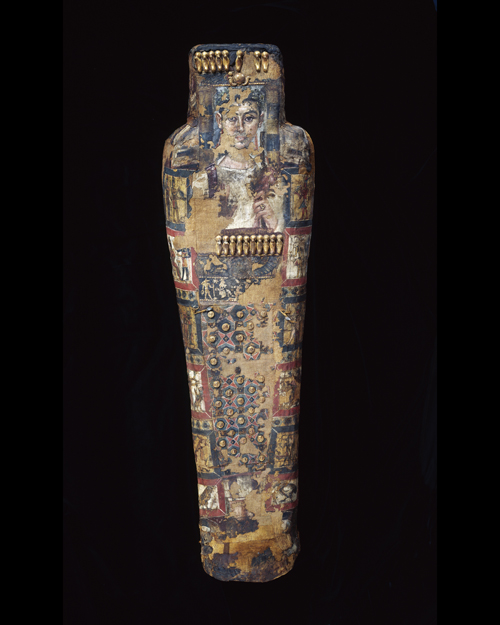
© 2003 Musée du Louvre / Georges Poncet
Antinopolis
225-250 AD
Mummy, wood, linen painted with distemper and encaustic
(for the portrait), gilded plaster
H.: 1.62 m; W.: 44 cm; D.: 27 cm
Department of Egyptian Antiquities, Musée du Louvre
(AF 6490)
The mummy, wrapped in its cocoon of linen strips, was placed on a plank of wood and attached with more strips of cloth. The whole thing was then placed in a painted shroud. According to x-ray analysis, this is the mummy of a boy 14 or 15 years old, which corresponds to the portrait.
The shroud imitates a naos-coffin, inside of which the deceased is depicted standing, the central part of the body being hidden by an elaborate decorative pattern studded with raised buttons of gilded plaster. The pale-complexioned face is set against a luminous blue ground, the head adorned with a wreath of myrtle leaves. The young man is dressed in a white tunic with purple bands. His right is open in a gesture of prayer and protection, while the left, wearing a ring, holds a garland of roses (having been judged worthy by Osiris) and a kind of baton.
Above his head is the Behedety emblem—a solar disk flanked by two uraei—made of gilded stucco, as are the two friezes of cobras. The name of the deceased, Ammon, son of Antinos, is inscribed in Greek in yellow paint against a red ground just below the bust. to the right and left of the deceased are Egyptian deities set in panels with alternating red and blue borders. The gods are Thot, Horus, Anubis, Isis-Hathor-Nut, Osiris, and the four sons of Horus. There are also depictions of the weighing of the heart, of the Eater of the West, and two images of the pharaoh.